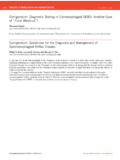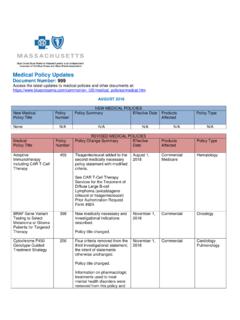Transcription of GLOBAL STRATEGY FOR ASTHMA MANAGEMENT AND …
1 GLOBAL STRATEGY FOR ASTHMA MANAGEMENT AND PREVENTIONREVISED2006 Copyright 2006 MCR VISION, Rights ReservedGlobal STRATEGY for ASTHMA MANAGEMENT and PreventionThe GINA reports are available on EXECUTIVE COMMITTEE*Paul O'Byrne, MD, ChairMcMaster UniversityHamilton, Ontario, Canada Eric D. Bateman, MDUniversity of Cape Town Cape Town, South Bousquet, MD, PhDMontpellier University and INSERMM ontpellier, FranceTim Clark, MDNational Heart and Lung InstituteLondon United KingdomKen Ohta. MD, PhDTeikyo University School of Medicine Tokyo, Japan Pierluigi Paggiaro, MDUniversity of Pisa Pisa, ItalySoren Erik Pedersen, MDKolding HospitalKolding, DenmarkManuel Soto-Quiroz, MDHospital Nacional de Ni osSan Jos , Costa Rica Raj B Singh MDApollo HospitalChennai, IndiaWan-Cheng Tan, MDSt Paul's Hospital,Vancouver, BC, CanadaGINA SCIENCE COMMITTEE*Eric D.
2 Bateman, MD, ChairUniversity of Cape Town Cape Town, South AfricaPeter J. Barnes, MDNational Heart and Lung InstituteLondon, UKJean Bousquet, MD, PhDMontpellier University and INSERMM ontpellier, FranceJeffrey M. Drazen, MDHarvard Medical School Boston, Massachusetts, USAMark FitzGerald, MDUniversity of British Columbia Vancouver, BC, CanadaPeter Gibson, MDJohn Hunter HospitalNSW, New Castle, AustraliaPaul O'Byrne, MDMcMaster UniversityHamilton, Ontario, CanadaKen Ohta. MD, PhDTeikyo University School of Medicine Tokyo, Japan Soren Erik Pedersen, MDKolding HospitalKolding, DenmarkEmilio Pizzichini. MDUniversidade Federal de Santa CatarinaFlorian polis, SC, Brazil Sean D.
3 Sullivan, PhDUniversity of WashingtonSeattle, Washington, USAS ally E. Wenzel, MDNational Jewish Medical/Research Center Denver, Colorado, USAH eather J. Zar, MDUniversity of Cape TownCape Town, South AfricaREVIEWERSL ouis P. Boulet, MDHopital LavalQuebec, QC, CanadaWilliam W. Busse, MDUniversity of WisconsinMadison, Wisconsin USANeil Barnes, MDThe London Chest Hospital, Barts and theLondon NHS TrustLondon , United KingdomYoshinosuke Fukuchi, MD, PhDPresident, Asian Pacific Society of RespirologyTokyo, JapanJohn E. Heffner, MDPresident, American Thoracic SocietyProvidence Portland Medical Center Portland, Oregon USADr. Mark LevyKenton Bridge Medical CentreKenton , United KingdomCarlos M.
4 Luna, MDPresident, ALATU niversity of Buenos AiresBuenos Aires, ArgentinaDr. Helen K. ReddelWoolcock Institute of Medical ResearchCamperdown, New South Wales, AustraliaStanley Szefler, MDNational Jewish Medical & Research CenterDenver, Colorado USAGINA Assembly Members Who SubmittedCommentsProfessor Nguygen Nang An Bachmai University Hospital Hanoi, VietnamProfessor Richard BeasleyMedical Research Institute New ZealandWellington, New ZealandYu-Zi Chen, MD Children's Hospital of The Capital Institute ofPediatrics Beijing, ChinaLadislav Chovan, MD, PhDPresident, Slovak Pneumological andPhthisiological SocietyBratislava, Slovak RepublicMotohiro Ebisawa, MD.
5 PhD National Sagamihara Hospital/Clinical Research Center for AllergologyKanagawa, JapanProfessor Amiran Gamkrelidze Tbilisi, GeorgiaDr. Michiko HaidaHanzomon Hospital,Chiyoda-ku, Tokyo, JapanDr. Carlos Adrian Jim nez San Luis Potos , M xicoSow-Hsong Kuo, MD National Taiwan University HospitalTaipei, TaiwanEva Mantzouranis, MDUniversity Hospital Heraklion, Crete, GreeceDr. Yousser MohammadTishreen University School of MedicineLattakia, SyriaHugo E. Neffen, MDChildren HospitalSanta Fe, ArgentinaEwa Nizankowska-Mogilnicka, MDUniversity School of MedicineKrakow, PolandAfshin Parsikia, MD, MPHA sthma and Allergy ProgramIranJose Eduardo Rosado Pinto, MDHospital Dona EstefaniaLisboa, PortugalJoaqu n Sastre, MDUniversidad Autonoma de MadridMadrid, SpainDr.
6 Jeana Rodica Radu N. Malaxa Hospital Bucharest, RomaniaMostafizur Rahman, MDDirector and Head, NIDCHD haka, BangladeshVaclav Spicak, MDCzech Initiative for AsthmaPrague, Czech Wong, MDChinese University of Hong KongHong Kong, ChinaGINA ProgramSuzanne S. Hurd, PhDScientific DirectorSarah DeWeerdtMedical EditorGlobal STRATEGY for ASTHMA MANAGEMENT and prevention 2006i*Disclosures for members of GINA Executive and Science Committees can be found at: ASTHMA is a serious GLOBAL health problem. People of allages in countries throughout the world are affected by thischronic airway disorder that, when uncontrolled, can placesevere limits on daily life and is sometimes fatal.
7 Theprevalence of ASTHMA is increasing in most countries,especially among children. ASTHMA is a significant burden,not only in terms of health care costs but also of lostproductivity and reduced participation in family life. During the past two decades, we have witnessed manyscientific advances that have improved our understandingof ASTHMA and our ability to manage and control iteffectively. However, the diversity of national health careservice systems and variations in the availability of asthmatherapies require that recommendations for ASTHMA carebe adapted to local conditions throughout the globalcommunity. In addition, public health officials requireinformation about the costs of ASTHMA care, how toeffectively manage this chronic disorder, and educationmethods to develop ASTHMA care services and programsresponsive to the particular needs and circumstanceswithin their 1993, the National Heart, Lung, and Blood Institutecollaborated with the World Health Organization toconvene a workshop that led to a Workshop Report.
8 GLOBAL STRATEGY for ASTHMA MANAGEMENT and presented a comprehensive plan to manage asthmawith the goal of reducing chronic disability and prematuredeaths while allowing patients with ASTHMA to leadproductive and fulfilling lives. At the same time, the GLOBAL Initiative for ASTHMA (GINA)was implemented to develop a network of individuals,organizations, and public health officials to disseminateinformation about the care of patients with ASTHMA while atthe same time assuring a mechanism to incorporate theresults of scientific investigations into ASTHMA based on the GINA Report were preparedand have been translated into languages to promoteinternational collaboration and dissemination ofinformation.
9 To disseminate information about asthmacare, a GINA Assembly was initiated, comprised of asthmacare experts from many countries to conduct workshopswith local doctors and national opinion leaders and to holdseminars at national and international meetings. Inaddition, GINA initiated an annual World ASTHMA Day (in2001) which has gained increasing attention each year toraise awareness about the burden of ASTHMA , and toinitiate activities at the local/national level to educatefamilies and health care professionals about effectivemethods to manage and control ASTHMA . In spite of these dissemination efforts, internationalsurveys provide direct evidence for suboptimal asthmacontrol in many countries, despite the availability ofeffective therapies.
10 It is clear that if recommendationscontained within this report are to improve care of peoplewith ASTHMA , every effort must be made to encouragehealth care leaders to assure availability of and access tomedications, and develop means to implement effectiveasthma MANAGEMENT programs including the use ofappropriate tools to measure success. In 2002, the GINA Report stated that it is reasonable toexpect that in most patients with ASTHMA , control of thedisease can, and should be achieved and maintained. To meet this challenge, in 2005, Executive Committeerecommended preparation of a new report not only toincorporate updated scientific information but to implementan approach to ASTHMA MANAGEMENT based on asthmacontrol, rather than ASTHMA severity.
















